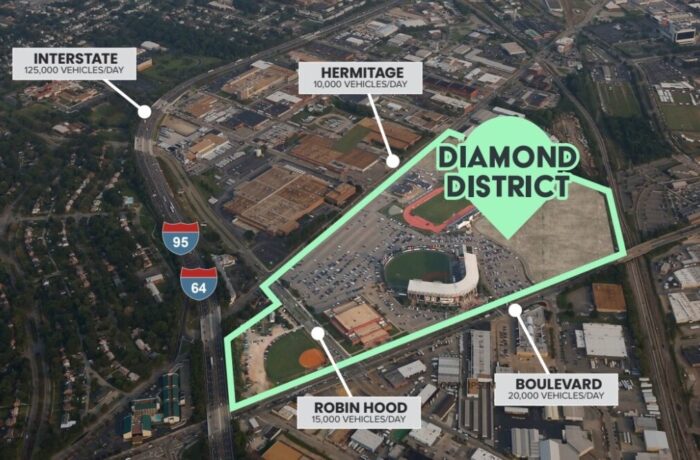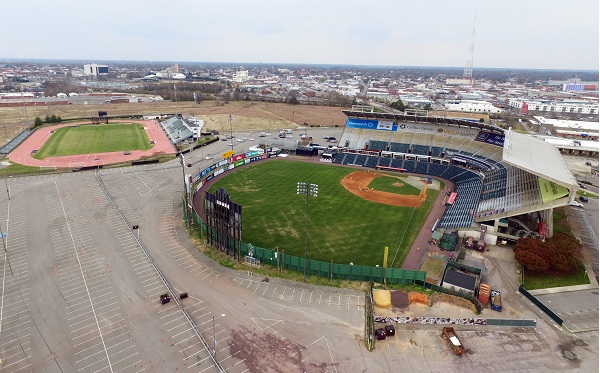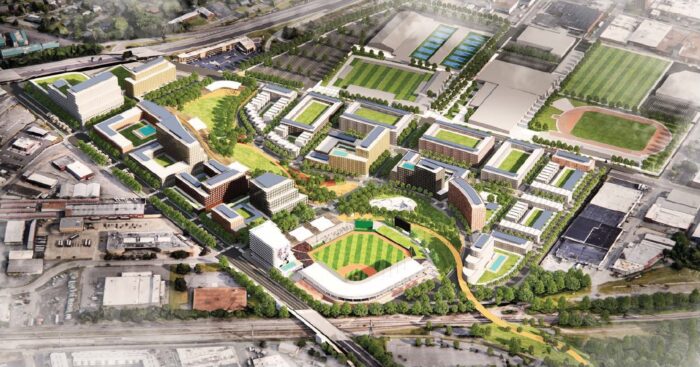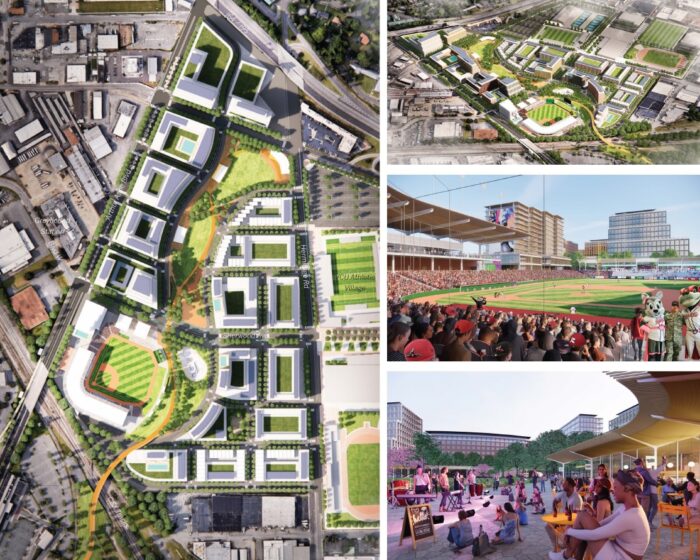
The 60-plus acres that make up The Diamond District are bordered by Arthur Ashe Boulevard, Hermitage Road, the interstate and the railroad tracks. (City of Richmond image)
The City of Richmond has made its pick in its months-long search for a development team to guide its Diamond District redevelopment.
The city announced Monday it is going with RVA Diamond Partners, led by D.C.-based Republic Properties Corp., Richmond-based developer Thalhimer Realty Partners (TRP) and Chicago-based investment bank Loop Capital.
The group was picked over Richmond Community Development Partners, led by Houston-based Machete Group, JMA Ventures out of San Francisco and New York-based Tryline Capital.
The selection tees up the long-anticipated development of the 67-acre, largely city-owned site that includes The Diamond, which is to be replaced with a new 10,000-capacity stadium. The rest of the land would be filled with a mix of office, residential and retail development, including a hotel and infrastructure upgrades.
It also draws to a close a nearly yearlong process that narrowed a field of prospective teams from 15 to two. Last month, the project’s evaluation panel eliminated a third finalist, Vision300 Partners, led by Boston-based Freehold Capital Management with members including Brookfield Properties and Hourigan.

The area that makes up the Diamond District includes the namesake baseball stadium and nearby Sports Backers Stadium. (BizSense file)
With its development team selected, next steps in the process include final project approval by the nine-member City Council, with a seven-vote supermajority required. That vote is expected later this year, with the goal of work starting on the new stadium early next year.
The city is aiming to deliver the new stadium by the start of the 2025 baseball season, the deadline set by Major League Baseball for all pro venues to meet new facility standards. The larger development is projected for completion over a 15-year period.
Republic Properties Corp., based in D.C., has developed mixed-use projects there including Washington Harbour on the Georgetown waterfront, Georgetown Park, Market Square and The Portals.
It’s working with TRP, which has made investments in recent years in areas around The Diamond, and Loop Capital, a Chicago-based investment bank that’s involved in the redevelopment of the Oakland Coliseum site in California and new terminals at LaGuardia Airport and JFK Airport in New York.
The city’s announcement included a comment from TRP’s Jason Guillot, who said the team “is thrilled to be selected to develop the Diamond District.”
“Our plan features an exciting new ballpark for the Flying Squirrels and VCU, an 11-acre public park and an overall vision that creates a dynamic and inclusive mixed-use urban community,” Guillot said. “Our plan provides important community benefits for all Richmond residents while serving as an iconic gateway for visitors to our great city.”
DLR Group and JMI Sports are the team’s stadium designer and development consultant, respectively. DLR’s minor-league baseball credits include Fluor Field stadium in Greenville, South Carolina, while JMI worked on Chase Center in San Francisco and Petco Park, home to Major League Baseball’s San Diego Padres.
Plan includes 11-acre park, income-based housing
Guillot has said the team’s proposal would follow the city’s recommendation of locating a new stadium along Arthur Ashe Boulevard just south of The Diamond, to allow the Richmond Flying Squirrels to continue playing ball while working to meet the 2025 season deadline.
The plan also includes components in keeping with the vision of the Richmond 300 master plan, including an 11-acre public park, minority business participation and a mix of housing styles and price and rental ranges.
Twenty percent of rental units would be targeted to households earning between 30 and 60 percent of the area median income, with at least 100 units reserved for renters with project-based vouchers. Twenty percent of homeownership units would be priced for households earning between 60 and 70 percent of AMI.
The team’s project involves a tax increment financing district, or TIF, that Guillot said would be restricted to the 67 acres that make up the project area. TIF districts are an option that local governments can use to help pay for a project using tax revenues generated over time.
The team had also pledged to forego any operating profits from the new stadium, and the city’s announcement said the team has commited to purchase the first $20 million of bonds to finance the new stadium, which is expected to cost about $80 million and fill 7 to 10 acres of the site.
The new stadium would seat 8,000 with space for 2,000 standing-room patrons. The 37-year-old Diamond, which has been deemed obsolete and unsuitable for renovation, currently seats about 9,500, with attendance for Flying Squirrels games averaging over 6,000.
The VCU-owned Sports Backers Stadium would be functionally replaced, along with the Arthur Ashe Jr. Athletic Center, by VCU’s planned athletic village complex across Hermitage Road.
The team’s proposal also included a workforce development center that would be located in Southside. The city’s announcement said the team would work with Richmond Public Schools to develop a technical training center at the former Altria site at Maury Street and Richmond Highway to create a workforce to support the development.
More than half of RVA Diamond Partners’ members are minority- or woman-owned businesses, according to the team. Minority business involvement was encouraged in the city’s solicitation for the project.
The team’s lead architect is New York-based Skidmore, Owings & Merrill. Other design firms on the team include Nelson Byrd Woltz, a landscape architecture firm out of Charlottesville; placemaking firm Groundswell Design Group, out of Philadelphia; Richmond-area firms Poole & Poole Architecture, KEI Architects and 510 Architects; and Hickok Cole, which has an office in Richmond.
The team’s hotel developer is Maryland-based Capstone Development. Its residential developers are Philadelphia-based Pennrose, Maryland-based NixDev and Richmond-based Southside Community Development & Housing Corp. Contractors on the team include Breeden Construction, Emerge Construction Group, M Companies, Prestige Construction and Whiting-Turner, all locally based.
Rounding out the group is Richmond-based J&G Workforce Development and PR firm Capital Results; D.C.-based consulting firm Robert Bobb Group; Richmond visual artist Sir James Thornhill; and food-and-beverage consultants Shemicia Bowen, Kelli Lemon and Amy Wentz, co-founders of Richmond Black Restaurant Experience.
A public meeting on the project and selection process is scheduled Wednesday at 6 p.m. at the Bon Secours Training Center at 2401 W. Leigh St. The meeting will be livestreamed. A telephone town hall also is scheduled Tuesday, Sept. 20, at 6:30 p.m. Participation instructions and more information are available on the project’s website.

The 60-plus acres that make up The Diamond District are bordered by Arthur Ashe Boulevard, Hermitage Road, the interstate and the railroad tracks. (City of Richmond image)
The City of Richmond has made its pick in its months-long search for a development team to guide its Diamond District redevelopment.
The city announced Monday it is going with RVA Diamond Partners, led by D.C.-based Republic Properties Corp., Richmond-based developer Thalhimer Realty Partners (TRP) and Chicago-based investment bank Loop Capital.
The group was picked over Richmond Community Development Partners, led by Houston-based Machete Group, JMA Ventures out of San Francisco and New York-based Tryline Capital.
The selection tees up the long-anticipated development of the 67-acre, largely city-owned site that includes The Diamond, which is to be replaced with a new 10,000-capacity stadium. The rest of the land would be filled with a mix of office, residential and retail development, including a hotel and infrastructure upgrades.
It also draws to a close a nearly yearlong process that narrowed a field of prospective teams from 15 to two. Last month, the project’s evaluation panel eliminated a third finalist, Vision300 Partners, led by Boston-based Freehold Capital Management with members including Brookfield Properties and Hourigan.

The area that makes up the Diamond District includes the namesake baseball stadium and nearby Sports Backers Stadium. (BizSense file)
With its development team selected, next steps in the process include final project approval by the nine-member City Council, with a seven-vote supermajority required. That vote is expected later this year, with the goal of work starting on the new stadium early next year.
The city is aiming to deliver the new stadium by the start of the 2025 baseball season, the deadline set by Major League Baseball for all pro venues to meet new facility standards. The larger development is projected for completion over a 15-year period.
Republic Properties Corp., based in D.C., has developed mixed-use projects there including Washington Harbour on the Georgetown waterfront, Georgetown Park, Market Square and The Portals.
It’s working with TRP, which has made investments in recent years in areas around The Diamond, and Loop Capital, a Chicago-based investment bank that’s involved in the redevelopment of the Oakland Coliseum site in California and new terminals at LaGuardia Airport and JFK Airport in New York.
The city’s announcement included a comment from TRP’s Jason Guillot, who said the team “is thrilled to be selected to develop the Diamond District.”
“Our plan features an exciting new ballpark for the Flying Squirrels and VCU, an 11-acre public park and an overall vision that creates a dynamic and inclusive mixed-use urban community,” Guillot said. “Our plan provides important community benefits for all Richmond residents while serving as an iconic gateway for visitors to our great city.”
DLR Group and JMI Sports are the team’s stadium designer and development consultant, respectively. DLR’s minor-league baseball credits include Fluor Field stadium in Greenville, South Carolina, while JMI worked on Chase Center in San Francisco and Petco Park, home to Major League Baseball’s San Diego Padres.
Plan includes 11-acre park, income-based housing
Guillot has said the team’s proposal would follow the city’s recommendation of locating a new stadium along Arthur Ashe Boulevard just south of The Diamond, to allow the Richmond Flying Squirrels to continue playing ball while working to meet the 2025 season deadline.
The plan also includes components in keeping with the vision of the Richmond 300 master plan, including an 11-acre public park, minority business participation and a mix of housing styles and price and rental ranges.
Twenty percent of rental units would be targeted to households earning between 30 and 60 percent of the area median income, with at least 100 units reserved for renters with project-based vouchers. Twenty percent of homeownership units would be priced for households earning between 60 and 70 percent of AMI.
The team’s project involves a tax increment financing district, or TIF, that Guillot said would be restricted to the 67 acres that make up the project area. TIF districts are an option that local governments can use to help pay for a project using tax revenues generated over time.
The team had also pledged to forego any operating profits from the new stadium, and the city’s announcement said the team has commited to purchase the first $20 million of bonds to finance the new stadium, which is expected to cost about $80 million and fill 7 to 10 acres of the site.
The new stadium would seat 8,000 with space for 2,000 standing-room patrons. The 37-year-old Diamond, which has been deemed obsolete and unsuitable for renovation, currently seats about 9,500, with attendance for Flying Squirrels games averaging over 6,000.
The VCU-owned Sports Backers Stadium would be functionally replaced, along with the Arthur Ashe Jr. Athletic Center, by VCU’s planned athletic village complex across Hermitage Road.
The team’s proposal also included a workforce development center that would be located in Southside. The city’s announcement said the team would work with Richmond Public Schools to develop a technical training center at the former Altria site at Maury Street and Richmond Highway to create a workforce to support the development.
More than half of RVA Diamond Partners’ members are minority- or woman-owned businesses, according to the team. Minority business involvement was encouraged in the city’s solicitation for the project.
The team’s lead architect is New York-based Skidmore, Owings & Merrill. Other design firms on the team include Nelson Byrd Woltz, a landscape architecture firm out of Charlottesville; placemaking firm Groundswell Design Group, out of Philadelphia; Richmond-area firms Poole & Poole Architecture, KEI Architects and 510 Architects; and Hickok Cole, which has an office in Richmond.
The team’s hotel developer is Maryland-based Capstone Development. Its residential developers are Philadelphia-based Pennrose, Maryland-based NixDev and Richmond-based Southside Community Development & Housing Corp. Contractors on the team include Breeden Construction, Emerge Construction Group, M Companies, Prestige Construction and Whiting-Turner, all locally based.
Rounding out the group is Richmond-based J&G Workforce Development and PR firm Capital Results; D.C.-based consulting firm Robert Bobb Group; Richmond visual artist Sir James Thornhill; and food-and-beverage consultants Shemicia Bowen, Kelli Lemon and Amy Wentz, co-founders of Richmond Black Restaurant Experience.
A public meeting on the project and selection process is scheduled Wednesday at 6 p.m. at the Bon Secours Training Center at 2401 W. Leigh St. The meeting will be livestreamed. A telephone town hall also is scheduled Tuesday, Sept. 20, at 6:30 p.m. Participation instructions and more information are available on the project’s website.



Council vote this year? What planet are you people on. Even if all goes well it won’t be introduced until the second meeting in September through Council committees in October and heard at a public hearing the first meeting in November. And that is if there’s no delays. The second meeting in November is almost always canceled for Thanksgiving, as is the second meeting in December. Council has promised, along with the mayor scheduled “lectures” this week, that we will have some real public meetings on the plan. Where are the details especially on the TiF? Great it’s only the… Read more »
I’m excited that the selection has been made and that public presentations will begin immediately. The financing has been structured as a TIF which will limit the public responsibility for the bond payments to the taxes raised within the 67 blocks. Certainly things can go haywire, but there’s been a great amount of due diligence put forward to date and the development team appears to be a solid one that won its bid through serious and honest competition. Its time to push forward. my one hang up is the limited accesses to the current confluence of Interstates 95 and 64.… Read more »
We’ve been at this place before on several projects including ballparks and coliseums. Happy to share an article from 2001 Mid-Atlantic Real Estate trade journal about the deal that was going to redo the Diamond for the Braves through RMA.. And by the way kudos to the city for announcing the public meeting on the same day as the first night the police chief is holding his public meetings across the coty that he had to reschedule because he didn’t give enough notice to the public. i truly hope it works out but it took the Building Commissioner, a council… Read more »
Glad to see this take the next step, this one was my second choice. Would have loved to see more verticality with a few buildings reaching over 12 if not 20 stories. Can’t wait to see the new stadium and new park on this plan. Along with the VCU Athletic Village and the other development around there going to see cranes in the air for a very long time soon. Here’s hoping that the City Council, the Mayor and Richmond don’t screw this up!
If completion is over a 15 year period I would have to believe the design is not “set in stone” already and would be fluid according to market conditions. It would be extremely difficult in the time frame they were given to have any type of functional designs on the 17 or so buildings I see in their renderings. Like any developer I would have to think that if they are “selling like hotcakes” they will make every move to maximize the number of residential units they can build on that piece of land.
I have looked at the renderings and haven’t been able to identify how 6000 let alone 8000 fans or concert goers will be able to park at the new stadium or how long it will take to enter or exit if there are parking decks involved.
agreed
that was my first thought…where will folks park?
There are these things called parking decks.
Sort of seems like they leave the parking out of these plans and renderings for this Diamond District and the Navy Hill proposal before it so that the developer can extort the city for parking garage funding at a later date…
I suspect the large block developments with the “grass” in the middle are probably “texas doughnut” style buildings with parking decks in the center and an outdoor amenity on top… there’s probably offices/apartments over podium parking, also.
It will also be interesting to see if anyone addresses the surrounding on and off ramps to 95 & 64. It must be considered. That area is a mess on a good day right now. The ramp to 64W at Laburnum has been closed for months, the ramp on AAB has a terribly short turning lane and there are accidents weekly at the A.P. Hill Monument when trying to access 64/95 a little farther up Hermitage. When you factor in all of the new residential going up in and around Scott’s Addition and Broad Street…please, RVA, do it right.
Good for the development; however, I have concerns about the stadium. How does a stadium cost get estimated at $80-100 million when private development 60 miles up the road in Fredericksburg was able to build a state-of-the-art stadium for an estimated $35 million just 2 years ago? I know there’s inflation to factor in – but that’s outrageous! Where is the other $45-65 million in cost? This isn’t major league baseball – it’s double-A baseball and it’s not going to be a tourist attraction like Fenway Park or Yankee Stadium. Why does this involve any type of tax-increment financing to… Read more »
Don’t the Kicker’s control City Stadium?
The City of Richmond is shown as the owners of the property that City Stadium is on. The Kickers (or whoever the tenant is) have done what they can with improving City Stadium; however how much money are they going to spend on a stadium they do not own?
The Kickers now have a long term lease and have been making improvements because of the assured time frame they will “control” the property. Up until a few years ago they had annual leases and obviously did not want to make improvements at that time.
The FredNats play in a much smaller, Single A stadium, Construction started before COVID, and it was on a completely vacant plot of suburban land. You can’t really compare the two projects.
There could be a fluctuation in costs – but not more than double the costs. The reason it’s so high is because the City of Richmond would be footing the bill in the end and there’s no oversight or accountability with it…especially since tax increment financing is involved. If they built the same stadium in Fredericksburg in Richmond it would be light years ahead of the Diamond…specifically in regard to handicap accessibility, restrooms, concessions, club suites, general seating, etc. along with being in compliance with MLB rules/regs. That stadium would be a perfect size for the Flying Squirrels and VCU… Read more »
Ok just so you know the difference in single a and double parks are kinda drastic because a ball has two levels now used to be three. There’s low a which is what Fredericksburg is then there is a advanced ball for every team then you have double a and from what I have heard I l have good ties from people I played ball with growing up and have heard the nationals want their triple a team here badly. I’ve heard that the rochester redwings will be demoted to double a and we will be triple a at some… Read more »
I don’t think there’s too much of a difference in single A and double A ballparks because…. There’s a baseball stadium in Binghamton, NY that was built in 1993 that is similar in size to the one in Fredericksburg. The team in Binghamton is a double-A baseball team and plays in the same league as the Richmond Flying Squirrels. I’ve been to this stadium and can tell you that the one in Fredericksburg is more advanced than this one. That stadium in Binghamton (Mirabito Stadium) cost to build in today’s dollars (approx. $8.88 million) is 1/10th of what is being… Read more »
If they are smart, they will design it to AAA standards, not AA. Richmond can easily attract a AAA team (as we had with the Braves). The Nats AAA club would be a natural fit in this market. This also gets the team into better regional competition with Norfolk and Charlotte, among others. Enough of Altoona and Bowie!
The cost do sound high but…. In comparison to the Fburg Nats stadium you are talking 5000 people to 10,000 people. Also construction started in Feb 2019 so I would assume it was bid in late 2018. There are many construction materials that are up 100% since that time frame. Also a lot depends on how you figure “cost”. For example do the parking decks that may be on the lower floors of adjacent buildings consider in the “cost of the ballpark”? I have seen figures of around 25K per space to build a parking deck, 1000 spaces would be… Read more »
I am sure the rendering is just that and not the final plan. But I really wish they had some condos right up against the outfield stands or either outfield standing room only areas. It would be really cool to have balconies overlooking the field and a combo of ground level restaurants and bars as well as a rooftop bar overlooking the ball park. Picture a Camden yards right field but instead of a warehouse you have condos where people can live and watch the game and a bar on the roof.
I hate baseball fans coercing taxpayers, but I DO like Camden Yards!